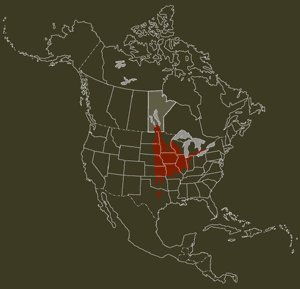Pre-Contact Landscape Description

Map of Tall Grass Prairie of North America–circa 1800
Before Europeans entered the interior of North America, there was a vast open area rich with wildlife. This was one of the most diverse and productive ecosystems in the world. A large portion of this grassland was the Tall Grass Prairie, which originally extended from southern Manitoba to the Texas border, occupying 1.5 million acres (.61 million hectares). In Canada, the main range of Tall Grass Prairie was a 2,316 sq mi. (6000 sq km) area in the Red River Valley. A 463 sq mi. (1200 sq km) zone in southern Ontario was the only other area it could be found. The Tall Grass Prairie ecosystem was dominated by grasses, many of which grew well over 3ft or 1m in height, and many millions of large grazing mammals that migrated over the prairie.
The prairie landscape was shaped by wild fire, drought, and grazing by mammals, all of which were essential to maintain the diversity of the area and to prevent trees and shrubs from encroaching and become the dominant species. Like all ecosystems the prairie experienced natural change as plant and animal species on the prairies flourished or declined, soil structure changed, and weathering and deposition altered the landscape.
The First Nations Peoples who lived on the prairie for thousands of years before Europeans arrived maintained a complex relationship with the plants and animals they relied on for survival. Archaelogical evidence indicates that the original inhabitants of the prairies shaped the landscape with fire, seasonal migration and hunting patterns.
Post contact the landscape was altered by several forces. One was the movement of aboriginal peoples from the forested areas east who came to occupy and use the land in a different manner than had been traditionally the case. The other was the influence the Europeans.
Sources
- Pettipas, Leo and Leigh, Syms E. Glimpses into the Precontact Archaeology of Southern Manitoba. Produced by Manitoba Department of Culture, Heritage and Historic Resources Branch and Manitoba Museum Archaeology Department: Winnipeg, 1990. 74 & 79.